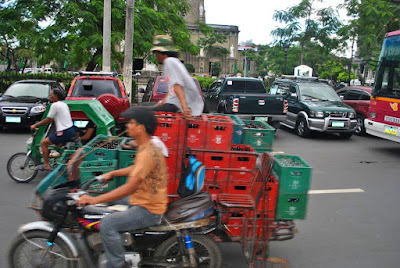skip to main |
skip to sidebar
Today we visited the Manila American Cemetery and Memorial, a beautiful memorial to WWII veterans and 36,286 servicemen missing in action, including 21 Medal of Honor recipients. The memorial, completed in 1960 consists of a small devotional chapel and two hemicycles faced with travertine limestone. There are eleven burial plots arranged in concentric circles around the memorial with 17,097 white marble headstones (consisting of 16,933 Latin crosses, 164 Stars of David, and 3,740 unknowns), which were quarried and fabricated in Italy. Twenty-five maps of marble and tinted concrete depect the battles of WWII. Meticulously maintained by the U.S. Government this is a beautiful place to rest.



 |
| Lunch at Market Market |
Intramuros was divided into four barrios, San Antonio, San Gabriel, San Carlos, and San Luis and was home to a rich and educated class of Spanish Filipinos called ilustrados who built grand houses. While World War II destroyed all residental buildings, Casa Manila, is a replica built from photos and archival building plans, recreating the lifestyle of the ilustrados through antique furniture, paintings, light figures, and other objects de art. Our guide asked if we wanted to go inside and accompanied us. At each room there was a sign in Tagalic and English, which he proceeded to read to us before hurrying us on to the next room. The house was built in the Spanish colonial style c. 1850. All the walls on the ground floors are made of adobe stones quarried from Bulacan. The uppermost floor consists of the living quarters and are made of wood, since wood is lighter than stone and is less hazardous during earthquakes. Unfortunately no photos were allowed other than on the patio.
 |
| Patio of Casa Manila |
Next we stopped to explore San Agustin Church, the first religious structure built on Luzon Island by the Spaniard Juan Macias. Completed in 1607 in the Spanish Colonial era, it is the oldest church still standing in the Philipppines. It was looted by British forces in 1762 during the Seven Years' War and was the only public building left standing after Manila was hit by an earthquake in 1863. It was named a National Historical Landmark by the Philippines Government in 1976 and designated as a World Heritage Site by UNESCO in 1994. There are fourteen side chapels and a trompe l'ce ceiling which was painted by Italian artists Cesare Alberoni and Giovanni Dibella in 1875. We were surprised to find paintings from the 18th Century hanging in the courtyard corridors; left to the exposure of the humidity they are bubbled and faded.
 |
| San Agustin Church |
Passing a small garden, Bob asked our driver to stop and he waited while be briefly stepped inside. Within the garden is Baluarte de San Diego, one of the oldest stone fortifications in Intramuros. It was designed and built by Jesuit priest Antonio Sedeño from 1586 to 1587. Began as a circular fort called Nuestra Señora de Guia, it was renovated to join the walls of the city in 1593, afterwhich it fell into disrepair. A new baluarte was completed between 1653 and 1663, which housed a foundry during the 18th century. It was breached by British forces in 1762 and restored, but was again damaged in 1863, this time by an earthquake. It was then condemned by the Spaniards and totally distroyed during the Battle of Manila in 1945.
 |
| Baluarte de San Diego |
The traffic in Manila can only be described as chaotic; congested with cars, buses, Jeepnees—an open-sided extended Jeep that sits 10-12 people on benches that run the length of each side—side-car bicycles/motorcycles, and motorcycles. There is no regard for lanes; where there are three lanes, they make into five. The rule seems to be: if the nose of your vehicle is in front, you have the right of way. Cars drive impressively close to each other and motorcycles and bicycles fill the gaps in-between. It is no wonder Bob and Mari have a Filipino driver.
One each side of the road are shanty villages—poverty is rampant. I tried to capture some of the visual impact; although shooting from a moving car was a challenge. People stand in the middle of the roads selling all manner of goods or sit beside the road selling single cigarettes.
On the way home our taxi driver tells us of a bus bombing in Makati where we were earlier in the day for lunch. It was a terrorist attack; a bomb detonated by a cell phone. Bob calls to check on the kids, whose school is not far from the bombing site. Four people are dead and fourteen wounded; as of yet, no group has taken responsibility.
















Wow - sounds intense. All beautiful, horrid, delightful, scary, and fascinating at once. Thanks for documenting so well and the pictures are stunning.
ReplyDeleteHi, I am a Filipino and i just finished reading your blog.. I found it a little funny about your experience while visiting intramuros. Yes, and I accept your opinion about the city. yes it is congested and populated since there are few universities inside it and I study there. and I could also say that Intramuros is not a very good touring site and it is not that "lovely" as you will expect that it should be. imagine a historical site in the heart of Manila, well of course it wont be maintained and preserved easily from the public. But if you really want to experience our history you should have gone far off the regional areas like Bataan/Corregidor/Vigan rather than touring Manila. But if you are staying near Intra I could say that it is a worth to pay a visit.
ReplyDeletejust to make things short, the whole intramuros is not that beautiful but there are few spots in it that were great and will make your visit worth it.
Thanks for visiting Intramuros.
PS:
I liked how do you said "if the nose of your vehicle is in front, you have the right of way"
yes it is a FACT.... almost :D
sorry about my english bro,
Eugene